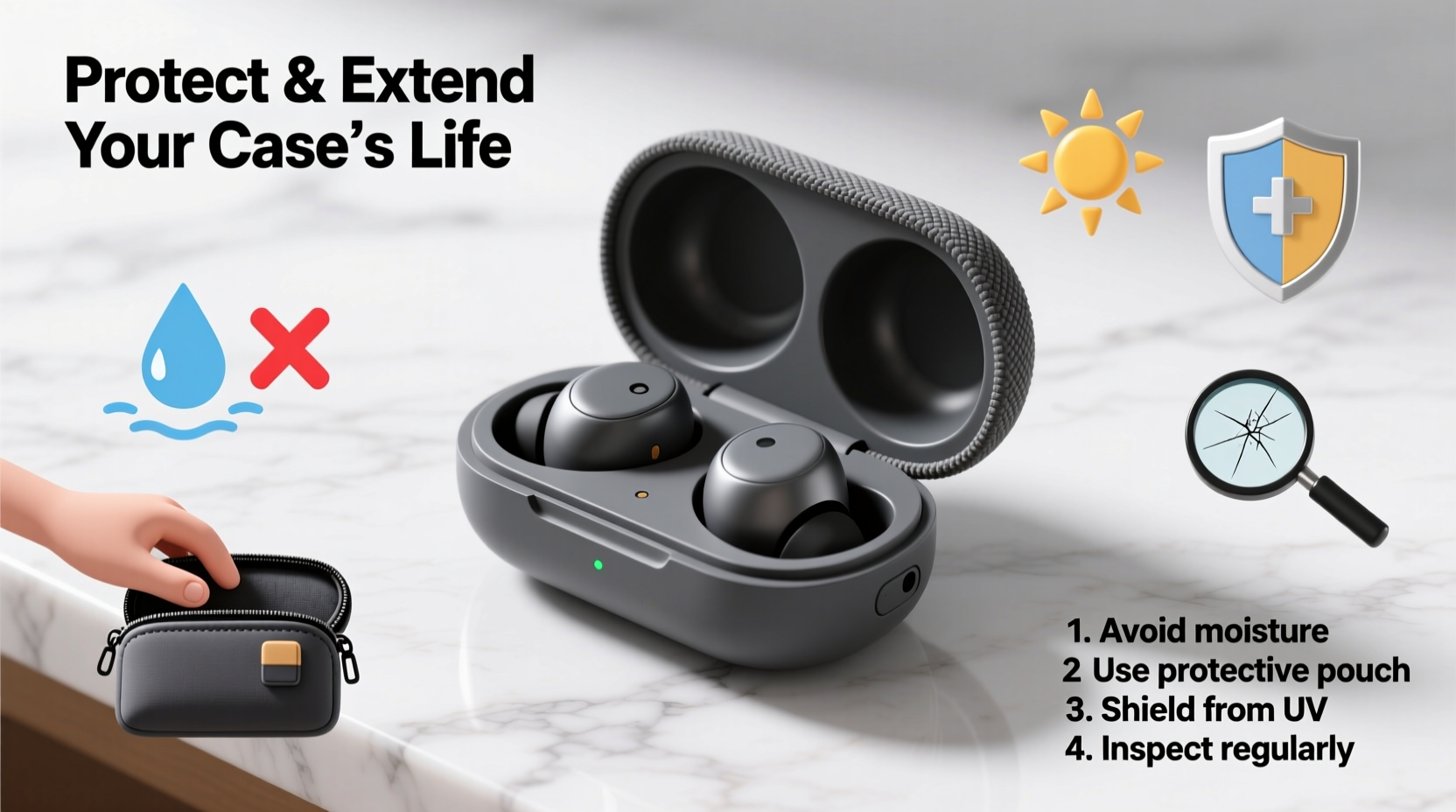Your headphone case is more than just a container—it's a protective shell that safeguards one of your most frequently used tech accessories. Whether you own premium wireless earbuds or over-ear headphones, the case plays a critical role in preventing scratches, dust buildup, moisture damage, and accidental drops. Yet, many users overlook its maintenance until cracks form, hinges weaken, or odors develop inside. With consistent care and smart habits, you can significantly extend the lifespan of your case, ensuring it continues to protect your investment for years.
1. Understand Your Case Material and Its Vulnerabilities

Not all headphone cases are created equal. The material determines how it responds to environmental stressors and what kind of care it needs. Common materials include:
- Hard plastic (polycarbonate): Durable but prone to scratches and cracking under impact.
- Silicone/rubberized coatings: Flexible and shock-absorbent, yet susceptible to tearing and absorbing oils from skin.
- Fabric-covered hard shells: Stylish and soft to the touch, but vulnerable to stains and fraying.
- Leather or faux leather: Premium feel, but sensitive to moisture, heat, and UV exposure.
Knowing your case’s composition helps you apply the right cleaning method and avoid damaging substances like alcohol wipes on sensitive surfaces.
2. Establish a Weekly Cleaning Routine
Dirt, sweat, and pocket lint accumulate quickly inside and outside the case. A simple weekly wipe-down prevents grime buildup that can degrade materials over time.
- Power down and remove devices: Take out your headphones or earbuds before cleaning.
- Exterior wipe: Use a microfiber cloth slightly dampened with water or a 50/50 mix of water and isopropyl alcohol (only safe for non-porous surfaces).
- Interior cleaning: Gently brush out debris with a dry toothbrush or use compressed air to dislodge dust from charging pins and crevices.
- Dry thoroughly: Never close the case while damp—moisture leads to mold, corrosion, and sticky residues.
Avoid soaking the case or submerging it in liquid. Even waterproof-rated cases aren’t designed for full immersion during cleaning.
3. Prevent Physical Damage with Smart Handling Habits
Most case failures stem from preventable physical trauma. Repeated dropping, over-tightening clasps, or placing heavy objects on top accelerates wear. Consider these everyday adjustments:
- Place the case in a dedicated compartment of your bag instead of loose at the bottom where it rattles against keys or chargers.
- Avoid slamming the lid shut; gentle closure preserves hinge integrity.
- Don’t toss the case into crowded spaces like gym lockers or car cup holders without protection.
“Cases with reinforced corners and internal padding last up to 60% longer when not subjected to daily impact.” — Dr. Alan Zhou, Product Durability Analyst at TechGear Labs
4. Optimize Storage Conditions
Where and how you store your case matters just as much as how you use it. Extreme temperatures, humidity, and direct sunlight compromise structural integrity.
| Storage Factor | Recommended Practice | What to Avoid |
|---|---|---|
| Temperature | Room temperature (18–24°C / 65–75°F) | Car dashboards, radiators, freezing environments |
| Humidity | Dry indoor areas with low moisture | Bathrooms, near washing machines, damp backpacks |
| Light Exposure | Shaded drawers or compartments | Windowsills, prolonged sun exposure |
| Position | Lid facing up, flat surface | Upside-down stacking, uneven pressure |
For long-term storage (e.g., seasonal headphones), place the case in a breathable fabric pouch with a silica gel packet to absorb ambient moisture.
5. Real-World Example: How One Traveler Extended Her Case Life by 3 Years
Sophie, a digital nomad based in Lisbon, uses her wireless earbuds daily for calls, music, and flights. After replacing two cases within 18 months due to cracked hinges and sticky interiors, she adopted a structured care plan:
- She began cleaning the case every Sunday night.
- Purchased a padded sleeve for her carry-on to isolate the case from other gear.
- Stopped leaving it on hotel nightstands near humidifiers or windows.
- Used a UV sanitizing box once a month to eliminate bacteria without chemicals.
Three years later, her third case still functions perfectly—no odor, no cracks, and the hinge remains tight. “It looks almost new,” she says. “I spend less money and feel better about reducing e-waste.”
Comprehensive Care Checklist
Follow this monthly checklist to keep your headphone case in peak condition:
- ✅ Wipe exterior with a dry or slightly damp microfiber cloth
- ✅ Clean interior with soft brush or compressed air
- ✅ Inspect hinges and clasp for looseness or debris
- ✅ Check charging port (if applicable) for dust or corrosion
- ✅ Store in a cool, dry place away from direct light
- ✅ Rotate between multiple cases if available (reduces wear on one unit)
FAQ: Common Questions About Headphone Case Maintenance
Can I wash my headphone case with soap and water?
Only if the manufacturer explicitly allows it. For most cases, a damp cloth is safer. Never immerse electronic cases in water—even if they’re labeled “water-resistant,” seals degrade over time.
Why does my case smell bad after a few months?
Odors usually come from trapped sweat, skin oils, or bacterial growth inside the lining. Regular cleaning and airing out the case (open lid for 10–15 minutes daily) help prevent this. You can also place a small charcoal deodorizer inside overnight.
Do protective skins or sleeves really help?
Yes. Silicone sleeves or neoprene covers add an extra layer of scratch and impact protection, especially useful for travelers or active users. Just ensure the added bulk doesn’t interfere with closing the lid properly.
Conclusion: Small Habits, Long-Term Protection
The longevity of your headphone case depends less on luck and more on consistency. Simple actions—like wiping it down weekly, storing it thoughtfully, and handling it gently—compound over time into significant savings and reduced environmental impact. Think of your case not as disposable packaging, but as an essential part of your audio ecosystem.









 浙公网安备
33010002000092号
浙公网安备
33010002000092号 浙B2-20120091-4
浙B2-20120091-4
Comments
No comments yet. Why don't you start the discussion?